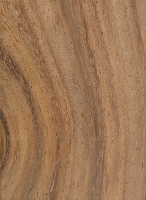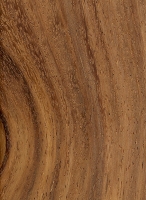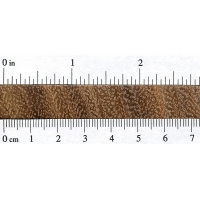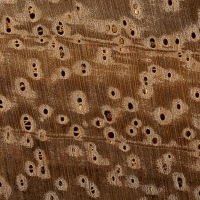 |
Common Name(s): Guanacaste, Parota Scientific Name: Enterolobium cyclocarpum Distribution: Primarily Central America, as well as Mexico and northern South America Tree Size: 65-100 ft (20-30 m) tall, 5-8 ft (1.5-2.5 m) trunk diameter Average Dried Weight: 27 lbs/ft3 (440 kg/m3) Specific Gravity (Basic, 12% MC): .34, .44 Janka Hardness: 470 lbf (2,100 N) Modulus of Rupture: 8,640 lbf/in2 (59.6 MPa) Elastic Modulus: 1,226,000 lbf/in2 (8.46 GPa) Crushing Strength: 5,390 lbf/in2 (37.2 MPa) Shrinkage: Radial: 2.2%, Tangential: 4.9%, Volumetric: 7.1%, T/R Ratio: 2.2 |
Color/Appearance: Heartwood is light to medium brown, sometimes with a reddish hue. Darker streaks of brown are sometimes present. Sapwood is pale yellow and is clearly demarcated from the heartwood.
Grain/Texture: Grain usually slightly interlocked. Very coarse texture. Moderate natural luster.
Endgrain: Diffuse-porous; solitary and radial multiples; very large pores in no specific arrangement, very few; mineral/gum deposits occasionally present; parenchyma vasicentric, confluent; narrow to medium rays, spacing wide.
Rot Resistance: Rated as durable to very durable; mixed insect resistance.
Workability: Easy to work with hand and machine tools. However, tearout is common during planing, and fuzzy surfaces may be seen after machining, especially on quartersawn surfaces. Glues and finishes well.
Odor: No characteristic odor.
Allergies/Toxicity: Although severe reactions are quite uncommon, Guanacaste has been reported to cause eye and respiratory irritation. See the articles Wood Allergies and Toxicity and Wood Dust Safety for more information.
Pricing/Availability: Because of the large trunk size, very large slabs of natural-edged Guanacaste are not uncommon (and their weight is generally much lighter than other imported hardwoods). Boards and other sawn lumber is also occasionally available. Prices should be moderate for an imported hardwood.
Sustainability: This wood species is not listed in the CITES Appendices or on the IUCN Red List of Threatened Species.
Common Uses: Furniture frames, table slabs, boatbuilding, millwork, and turned objects.
Comments: Guanacaste has a unique appearance and texture, which is mostly due to its very large pores, which give it a somewhat coarse-textured, almost fibrous look.
None available.
None available.








I’ve got a nice size cookie and was thinking of turning a large bowl. Is it safe? I do plan to finish with food grade epoxy
I’m not sure if you’re wondering if it’s safe to turn or safe to use as a food bowl, so I’ll do my best on both fronts. I find the sawdust to be very irritating when sanding or planing. If I don’t use great quality dust extraction and/or a cartridge respirator, then sneezing is guaranteed, and headaches and nausea are not uncommon. With common sense, dust control and perhaps a respirator, you should have nothing to worry about. By all means, use a respirator – I’m in Florida, and the weather sometimes makes it challenging to wear a mask while… Read more »
I want to put out a fair warning to anyone working with this wood. It says that there are reports of eye and respiratory irritation, but working with the dust in the air feels more like being lightly pepper sprayed. I made a table with a slab of it and its beautiful, but can really hurt. Be safe, wear lung and eye protection!
Hey guys I make guitars and I Love the look of this wood (Parota/Guanacaste) it’s also so lightweight and low price. But like everything thing in life, if it seems to good to be true it usually is. And that’s because of the dust, if you have immaculate dust collection than you have no worries really. But if not, the dust is obnoxious and even with a full respirator the dust is going to cause respiratory issues. Be careful. It may not be toxic but will still make you sick.
I am having a coffee table made of this. What should it be sealed with that would bring out the design in the wood, but keep it protected?
I build with this wood all the time. For a coffee table, I’d recommend two coats of Rubio Monocoat, or Oslo Polyx oil/wax. They really bring out the beauty of the wood.
Hello . Can this wood be used for exterior doors in south Texas extreme heat ?
I have three small pieces of guanacaste to use as table tops. Are there restrictions for bringing these into the US (from Honduras) in my luggage? Do I need any form of documentation?
I just bought a dining table made of Guanacaste and it has a whitish sheen. How can I make it look more rich and protect it for daily use?
What do you mean by a whitish sheen? Are you referring to a matte / satin finish on the topcoat, or something else making the wood appear paler than normal? If the former, you could apply a high gloss topcoat of polyurethane, but you’d have to be careful and clean the surface with a solvent first and check for proper adhesion. For a beginner,, it can be very easy to make a mess of a table top if brushing on polyurethane, so something like a wipe-on poly finish might be a safer route. Otherwise, a lower-stakes finish to apply would… Read more »
should this wood be stabilized before turning
only in the sap(white) sections… But have in mind that it prodces “dust” instead of sawdust. Use a good respirator and sealed glasses. And use really sharp tools because once dry it hardens good and you can get burn marks all over the place
Will this wood be suitable for kitchen cabinets?
It’s perfect for kitchen cabinets.
Such a beautiful wood. It is the national tree of Costa Rica, where I live.
I’ve been recommended to use this for an outdoor deck by many lumber yards in Mexico yet I’m also hearing it doesn’t do well in the sun and will twist, split and splinter. Is it a good decking choice or not for a deck on the Mexican Pacific coast?
Thanks.
Its hardness rating is really low and I would think therefore that it would not wear well with constant foot traffic on it. Surprised about using for a deck, as it is easily distorted if moisture content not properly aged and then properly sealed.
I have a general questions that I hope someone can help with. We just purchase a beautiful live edge parota dining table. Where it was displayed was in a large humid warehouse. When we got it home, the table was definitely uneven. We further determined that the wood was a bit warped. Any recommendations help fix that or do you think that the inside conditions/temperature of the house will settle the wood? We absolutely LOVE the table but it won’t work if it is slanted. Any help/suggestions would be greatly appreciated.
Can you attach pictures, including pics of the base/how the slab is attached to the table base? Any further details about the warping would be helpful to know as well.
Take it to a cabinet shop with a CNC machine and they can flatten it with a fly cutter bit.
Hello, great page. Does any one knows what is the ideal humidity to work with parota to avoid twisting or cracking? also, any ideas on diy drying with out an oven?
Since this is listed as a hardwood, could it be used as a cutting board? I have a single block 15x8x4 and it seems like a good use for it. I would use Odies Oil to food safe treat it. I would welcome any commments
I’ve never used it, but its Janka is only 470. That’s too soft for a cutting board in my opinion. For reference, This site has black cherry listed at 950, and walnut at 1,010.
Not good for cutting boards. It’s tempting because the grain/color is nice but it’s too porous and soft. Local woods here in Mexico include mesquite, red euc., primavera, all good for cutting boards.
As a purely decorative cutting board (how all cutting boards should we used), it will look fine. As a functional one, it is much too soft. Use polypropylene instead.
My thought was to build my whole house in Costa Rica using Guanacaste lumber to get fungal and insect protection. Is it too light to use for structural???
this wood would be fine to build a house out of
Does any one know the moisture setting for this wood on a moisture meter making veneer out of it
Does anyone know if we can use this wood to make exterior tables?
the store Timber Woodworking Machinery in Mesa Arizona has plenty, including a few large slabs!
In El Salvador used for furniture, doors, beds, shelves. Known as “conacaste”, a word from the local Nahuat language meaning “ear tree” because of the shape of its seed pods (interesting to read about similar usage in Hawaii). As everyone else observes, its sawdust is very irritating to the lungs and eyes. One way to banish bats from a building is to ignite conacaste shavings (sprinkled with a bit of water) in a pan and let them smolder in the building.
Parota’s two-tone colouring makes beautiful wooden furniture, which we came across a lot of in Mexico in very large sizes. We’re now working solely with parota wood at https://www.parotas.com, and the natural lustre really shows up well just by sealing it with oils.
I just bought a large slab 3.50m x 1.10 going to make a 12 person dining table, any tips or suggestions. How does this wood finish with oil vs polyurethene ?
Hi
Is Parota wood good for a large exterior double door in Cabo Mexico? We need a hard wood that can resist in high heat and humidity, sun, termites and rot from the sea air.
Thanks
I’ve used both mineral oil and polyurethane on parota. For just beauty, my preference is the oil, but if you want a more durable finish us polyurethane.
Hi Casey,
I am trying to find an expert on the wood. You’re site is beautiful by the way.
I have a slab that is my leather studio work table. I would like to use it without treating it with oil. Should I be concerned that it will ruin? If I need to treat it do you have an oil recommendation that will leave it looking natural as possible without a shine?
Thanks, Gisele
Hi Gisele, try polyurethane. It gives an amazing finishing while you protect it
We call it “sneeze wood” in Hawaii. Really rough on the lungs. THis wood is really beautiful and can be a look alike for big island koa with its red coloration. Very similar to monkey pod but with the red hue added. It is rather soft and a lot lighter than most other slabs. Goes by “Parota” with most US retailers. Called Ear pod sometimes in Hawaii due to some seriously strange ear shaped seed pods.
This is very true. I just finished a high top table with this. Turned out great but during the sanding and planning of this wood I had to keep a dust mask on even with a vacumm connected to the equipment.
You need a really good respirator when cutting parota. I just bought a supplied air respirator and have no problem.
“No characteristic odor,” huh? The sawdust from this stuff is like cayenne powder. If you’ve got a dustmask on and get just a bit in your nose, you’ll be sneezing the rest of the day.
that is one beautiful wood!